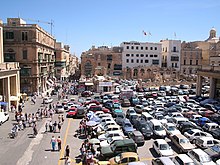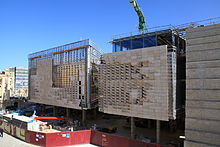
Renzo Piano is an Italian architect. His notable buildings include the Centre Georges Pompidou in Paris, The Shard in London (2012), the Whitney Museum of American Art in New York City (2015), İstanbul Modern in Istanbul (2022) and Stavros Niarchos Foundation Cultural Center in Athens (2016). He won the Pritzker Architecture Prize in 1998.

Valletta is the capital city of Malta and one of its 68 council areas. Located between the Grand Harbour to the east and Marsamxett Harbour to the west, its population as of 2021 was 5,157. As Malta’s capital city, it is a commercial centre for shopping, bars, dining, and café life. It is also the southernmost capital of Europe, and at just 0.61 square kilometres (0.24 sq mi), it is the European Union's smallest capital city.
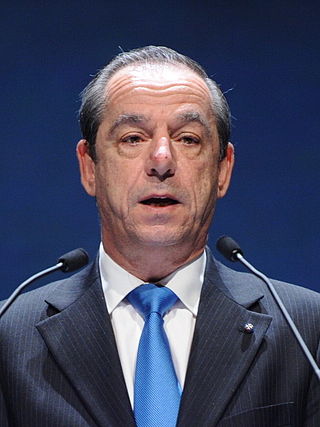
Lawrence Gonzi is a Maltese politician, retired Nationalist politician and lawyer, who served for twenty-five years in various critical roles in Maltese politics. Gonzi was Prime Minister of Malta from 2004 to 2013, and leader of the Nationalist Party. He also served as speaker of the House from 1988 to 1996, and Minister of Social Policy from 1998 to 2004, as well as Deputy Prime Minister from 1999 to 2004. He served in practically all positions in Parliament, being also Leader of the House, an MP and Leader of the Opposition.
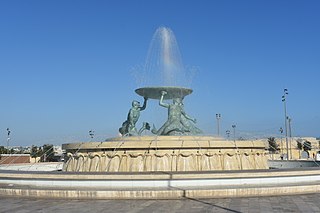
The Tritons’ Fountain is a fountain located in Floriana, Malta. It consists of three bronze Tritons holding up a large basin, balanced on a concentric base built out of concrete and clad in 730 tons of travertine slabs. The fountain is one of Malta's most important Modernist landmarks.

City Gate is a gate located at the entrance of Valletta, Malta. The present gate, which is the fifth one to have stood on the site, was built between 2011 and 2014 to designs of the Italian architect Renzo Piano.

Saint James Cavalier is a 16th-century cavalier in Valletta, Malta, which was built by the Order of St John. It overlooks St James' Bastion, a large obtuse-angled bastion forming part of the Valletta Land Front. St James was one of nine planned cavaliers in the city, although eventually only two were built, the other one being the identical Saint John's Cavalier. It was designed by the Italian military engineer Francesco Laparelli, while its construction was overseen by his Maltese assistant Girolamo Cassar. St James Cavalier never saw use in any military conflict, but it played a role during the Rising of the Priests in 1775.

The Royal Opera House, also known as the Royal Theatre, was an opera house and performing arts venue in Valletta, Malta. It was designed by the English architect Edward Middleton Barry and was erected in 1866. In 1873 its interior was extensively damaged by fire but was eventually restored by 1877. The theatre received a direct hit from aerial bombing in 1942 during World War II. Prior to its destruction, it was one of the most beautiful and iconic buildings in Valletta. After several abandoned plans to rebuild the theatre, the ruins were redesigned by the Italian architect Renzo Piano and in 2013 it once again started functioning as a performance venue, called Pjazza Teatru Rjal.

The Grandmaster's Palace, officially known as The Palace, is a palace in Valletta, Malta. It was built between the 16th and 18th centuries as the palace of the Grand Master of the Order of St. John, who ruled Malta from 1530 to 1798, and was also known as the Magisterial Palace. When the knights were expelled by Napoleonic France, it became the National Palace. During the period of British rule beginning in 1800, it was the Governor's Palace.

Maltese architecture has its origins in prehistory, and some of the oldest free-standing structures on Earth – a series of megalithic temples – can be found on Malta. The islands were colonized by the Phoenicians and later the Romans, who established the cities of Melite and Gaulos, and then by the Arabs of Ifriqiya. Although these were substantial settlements and are known to have had numerous temples, churches and palaces, few remains have survived apart from some architectural fragments.
The 2007–08 Maltese FA Trophy was the 70th season since its establishment. It featured 20 teams from Maltese Premier League and First Division. The competition started on 3 November 2007 and ended on 24 May 2008 with the final, which Birkirkara F.C. won 2–1 against Hamrun Spartans.

The Malta Railway was the only railway line ever on the island of Malta, and it consisted of a single railway line from Valletta to Mdina. It was a single-track line in metre gauge, operating from 1883 to 1931. The railway was known locally in Maltese as il-vapur tal-art.
Franco Debono is a Maltese criminal trial lawyer and former Nationalist member of Parliament.
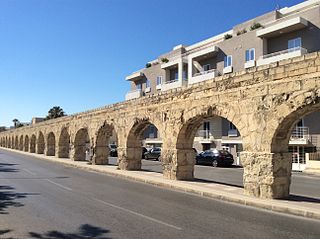
The Wignacourt Aqueduct is a 17th-century aqueduct in Malta, which was built by the Order of Saint John to carry water from springs in Dingli and Rabat to the newly built capital city Valletta. The aqueduct carried water through underground pipes and over arched viaducts across depressions in the ground.

The Auberge d'Auvergne was an auberge in Valletta, Malta. It was built in the 16th century to house knights of the Order of Saint John from the langue of Auvergne. It became a courthouse in the 19th century, and it remained so until it was destroyed by aerial bombardment in 1941. The site is now occupied by the Courts of Justice building, which was constructed in the 1960s.

The Fortress Builders – Fortifications Interpretation Centre (FIC) is an interpretation centre about the fortifications of Malta. It is housed in a late 16th-century warehouse located near the St. Andrew's Bastion in Valletta, Malta. The centre was opened in 2013, and it aims at communicating Malta's military architecture in an interactive way.

The Wignacourt Arch known as the Fleur-De-Lys Gate is an ornamental arch located on the boundary between Fleur-de-Lys and Santa Venera, Malta. The arch was originally built in 1615 as part of the Wignacourt Aqueduct, but it was destroyed between 1943 and 1944. A replica of the arch was constructed in 2015 and inaugurated on 28 April 2016.
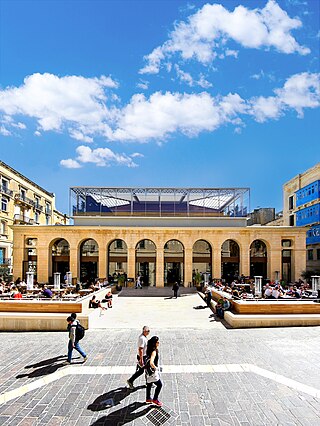
Is-Suq tal-Belt, also known as the Covered Market, is a 19th-century market hall located in Valletta, Malta. It is notable for being the first building in Malta to be constructed mostly of iron. The building was severely damaged in World War II, and the rebuilding was insensitive to the original structure. Further alterations were made in later decades, and the market began to decline in the 1970s. An attempt to rebrand it as a shopping arcade known as Ixtri Malti in the 1980s was unsuccessful. The market continued to decline until it was renovated in 2016–17, and reopened as a food market in January 2018.

Republic Street, historically known as Strada Reale or Kingsway, is a principal street in the capital city of Valletta, Malta. It is about 1 kilometer long and is known for legislative, judiciary and commercial purposes. It is mostly pedestrianised.
The 2017–18 Maltese Premier League was the 103rd season of top-flight league football in Malta. The season began on 18 August 2017 and ended on 22 April 2018. Hibernians were the defending champions, having won their 12th title the previous season.
Justin Tellus is a Malta former footballer who played as a defender, featuring in the Maltese Premier League and UEFA Cup.



